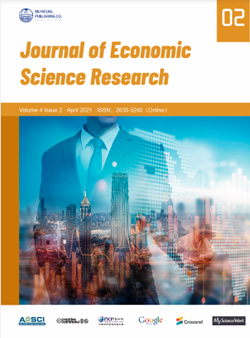A Study on Economic Impact in the Context of American Election Based on AHP
DOI:
https://doi.org/10.30564/jesr.v4i2.2775Abstract
To assess the economic impact of the different policies of the Trump and Biden candidates, we formulate metrics on five aspects: Covid-19 prevention and control measures, environmental protection policies, taxation, health care reform, foreign trade. Moreover, each metric is subdivided into several secondary metrics, making a three-tier hierarchical structure. Take environmental protection policy as an example: Without direct data under Biden’s policies, we collected data on U.S. CO2 emissions and U.S. oil consumption during Obama’s presidency as Biden’s legacy. First, use the analytic hierarchy process (AHP) to select indicators that can reflect the U.S. economy and determine the weight of each indicator. For the U.S. economy, Biden scored 2.6498, Trump 2.3502, suggesting that the election of Biden might make things better for the economy. For China’s economy, Biden scored 0.6810 and Trump 0.3245, meaning Biden could give the Chinese economy more room to grow. To reduce the influence of AHP subjectivity on the results, the Pearson correlation coefficient is introduced to establish the P-AHP model. Take the impact on China’s economy. Biden scored 0.5846 and Trump 0.4154.
Keywords:
AHP, American presidential election, Pearson correlation analysis, EconomyReferences
[1] Mu Ren et al. MATLAB and Mathematical Modeling [M]. Science Press, 2018.
[2] Zhuo Jin-wu et al. Mathematical Modeling Method and Practice of MATLAB [M]. Beijing University of Aeronautics and Astronautics Press,2018.
[3] Liao Zizhen. Analysis on the impact and countermeasures of America’s withdrawal from TPP on China’s foreign trade economy [J].Time Financial,2018(08):7-8.
[4] Lie Chun. Obama Administration’s Measures to Support the Development of New Energy Industry [J]. Construction Machinery, 2010,41(01): 73.
[5] Zhou Yapeng. Research on Trump Administration’s “America First” Trade Policy [D]. Liaoning University,2019.Liao Zizhen. Analysis on the impact and countermeasures of America’s withdrawal from TPP on China’s foreign trade economy [J].Time Financial,2018(08):7-8.
[6] Xiao Junpeng. The Adjustment of the Trump Administration’s economic and trade policy towards China and its impact on China-Us relations [D].Xiangtan University, 2019.
[7] Liu Yang, Li Kegang, Li Mingliang, et al. Study on goaf stability based on AHP- fuzzy evaluation [J]. Nonferrous Metals Engineering, 2020,10(11): 114- 119.
[8] Wang Hainan. Research on Trump’s trade policies and possible Trade Conflicts with China from the perspective of political economy [D].Guangxi University,2018.
Downloads
Issue
Article Type
License
Copyright and Licensing
The authors shall retain the copyright of their work but allow the Publisher to publish, copy, distribute, and convey the work.
Journal of Economic Science Research publishes accepted manuscripts under Creative Commons Attribution-NonCommercial 4.0 International License (CC BY-NC 4.0). Authors who submit their papers for publication by Journal of Economic Science Research agree to have the CC BY-NC 4.0 license applied to their work, and that anyone is allowed to reuse the article or part of it free of charge for non-commercial use. As long as you follow the license terms and original source is properly cited, anyone may copy, redistribute the material in any medium or format, remix, transform, and build upon the material.
License Policy for Reuse of Third-Party Materials
If a manuscript submitted to the journal contains the materials which are held in copyright by a third-party, authors are responsible for obtaining permissions from the copyright holder to reuse or republish any previously published figures, illustrations, charts, tables, photographs, and text excerpts, etc. When submitting a manuscript, official written proof of permission must be provided and clearly stated in the cover letter.
The editorial office of the journal has the right to reject/retract articles that reuse third-party materials without permission.
Journal Policies on Data Sharing
We encourage authors to share articles published in our journal to other data platforms, but only if it is noted that it has been published in this journal.




 Yang Yue
Yang Yue

